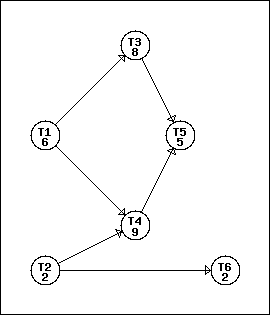
Consider the order-requirement digraph above, and the priority lists given below:
List 1 : T3,T4,T2,T6,T5,T1
List 2 : T2,T4,T1,T5,T6,T3
List 3 : T6,T2,T4,T5,T3,T1
Using Priority List 1, apply the list-processing algorithm to schedule the 6 tasks on 3 processors. Enter the task labels and idle times (if any) in order for each processor, separated by commas. For example: 3,T1,T2,4,T5,6
Processor 1 :
Processor 2 :
Processor 3 :
Using Priority List 2, apply the list-processing algorithm to schedule the 6 tasks on 3 processors.
Processor 1 :
Processor 2 :
Processor 3 :
Using Priority List 3, apply the list-processing algorithm to schedule the 6 tasks on 3 processors.
Processor 1 :
Processor 2 :
Processor 3 :
Which priority list(s) will be completed in the least amount of time : 1, 2 or 3? Comma separate and order the list numbers, if more than one list has the smallest completion time.
List number(s) =
What is the smallest possible completion time?
Completion time =
You can earn partial credit on this problem.